 |
The SLOA (Steam Locomotive Operators Association) had a set of stock spcifically for charters, not always steam-hauled.
In August 1985 there were three private charters to Stratford-upon-Avon two of which used class 47 locomotives
and another I had forgotten about with 31430. I just had time after work to go home, grab a camera, have a word with Mick Lloyd the signalman and
climb up the bracket signal just outside the station for this view. Everything, with the sole exception of the tower and spire of Holy Trinity church in the extreme
right backgound, has changed beyound recognition. The huge Stratford Canners food processing factory has gone and is currently a derelict site
with the threat of some 500 homes, including an 8 storey apartment block, being built on it. The gasholders, signalbox, goods loop, open space and chimneys have been demolished
with various industrial units built instead.
|
 |
When there was a major British Leyland car factory at Longbridge there were 2 or 3 trains of parts between the plant and that at Swindon.
This picture dated 8 August 1985 from Leamington Spa shows 31112 passing on the up main line with the ferrywagons going back to Swindon to collect
another load for the "just in time" system which avoided the need for large stocks to be held at Longbridge. This working could have any class of locomotive allocated
to it from whatever there was at Saltley depot. I saw classes 25, 31, 37, 45, and 47 being used and it's likely that others found their way onto it too.
|
 |
A friend from work and I had a trip to Leicestershire on 15 August 1985 and spent an hour or so at Cossington on the Midland Main Line.
For most of the day the light was mediocre but we took most of what came along including 31101 on a set of fuel tankers with an unrecorded
light engine in the background just about to the leave the scene.
|
 |
Just a few moments after the picture shown above was taken at Cossington on 15 August 1985 more class 31s appeared in the
form of 31260 + 31280 taking some loaded and some empty ballast wagons from I guessed, in the absence of any information or WTT, Mountsorrel quarry.
|
 |
This is the sort of train that isn't seen in 2025 when I scanned this slide. It was taken at Reading on 18 May 1985 as 31273 took a few wagons through the Station towards Didcot.
I imagine that that was a transit move of crippled wagons going for repair but as usual at the time there was no information available to me.
|
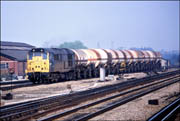 |
Another one from Reading on 18 May 1985 as 31255 left a trail of exhausr over the eastern end of the station area with a heavy load of
tanks containing liquefied gas. To more modern eyes it seems incredible that heavy trains were in the hands of small locomotives
but that was what made photographing the scene at the time so much more fulfilling than it is in 2025.
|
_45026_Bish_280394) |
In the short time that the inspection saloon took to reverse at Stratford-upon-Avon the sun disappeared which allowed me to move to the other
side of Bishopton Lane for a shot of 31455 leading, with red lights still illuminated, back towards Birmingham.
Every trace of green, except of course for that immediately alongside the lines which has flourished unchecked, has gone and replaced with
various commercial and residential properties. Work on the extension to Timothy's Bridge Road has commenced and a bonfire to get rid of some of the greenery has been lit
in the background. The bridge has also been replaced with
a bigger version with much higher parapets and with a proper footpath rather than the orignal grass verge.
|
 |
Class 31 was the standard motive for most civil engineering train to and from Bescot in 1994. On 17 June I spent a few hours
on a roadbridge near the village of Great Brington on the Northampton Loop and soon had this shot of 31524 taking such a train to Northampton.
|
_GtBring_170694) |
It wasn't long before 31524 came back along the Northampton Loop on 17 June 1994 with a couple of large ballast hoppers and some flat wagons. Judging by the
tree growth in 1994 I can't imagine that equivalent picture would be worth the effort in 2024.
|
 |
About 45 minutes after the shot above was taken another departmental, this time from Bletchley to Bescot came along.
This time it was InterCity liveried 31405 which made a welcome and colourful sight amongst all the greenery on 17 June 1994.
|
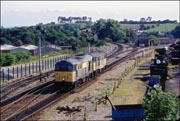 |
Information on infrequent freight trains was always easy to come by on 1993 so I was fortunate to have been told that one of the
trips to Honeybourne Tip was running on 25 June. There were no details about consists but I went to Droitwich Spa for a shot as
the train from Bescot left the line from Stoke Works Junction and was mildly disappointed that 31110 + 31155 appeared running light
engine a few minutes after 56053 accelerated past with a Brierley Hill to Cardiff empty steel train.
|
 |
It seemed likely that some empty wagons would be taken from Honeybourne Tip on 25 June 1993 so I drove to the station at Honeybourne for that part of the diagram.
The light was never going to great in the late morning and the black & white shot came out much better than the colour in the heavy backlighting.
The single-line token for the Long Marston branch was kept in what looked like a broom cupboard and once the token
was in the ground frame and permission given by the signaller at Evesham to release the points the train could move over onto the main line.
The stubble burning in the field behind the line is something that wouldn't be seen in 2024 having long since been banned on environmental grounds.
|
 |
Thi seemed like a bit of a throwaway shot in 1993 but I am glad in 2024 that I kept the slide and was able to scan it.
It shows the station at Honeybourne on 25 June, the empty car park that was usually the case then, the single track North Cotswold with its very basic service and
the background clear of any development other than a caravan park.
|
 |
Weed control trains in 1985 looked very different in 1985 than in 2024. This shows the Chipman No.5 train headed by 31146 approaching Stratford-upon-Avon station on
24 June. This picture was taken at just before 06.00 and before the first passenger train of the day from Birmingham Moor Street had arrived.
|
 |
Croft quarry in Leicestershire supplied Bescot Yard with one or two trains most weekdays. This image shows 31438 in the loop at Whitacre Junction on 13 May 1992 in the days
before the vegetation took over making such a picture impossible.
|
 |
The Wilmcote station did not see many locomotive-hauled trains in 1984 so on Sunday 25 February the visit of 31301 + 25287 was more than welcome. The engineering possession commenced at the station and this train
was standing just outside the work area. I waited for quite a while on an occupation bridge to the south of the station, but as is usual on these occasions, there was no movement and the locomotives remained switched off
for several hours. Here is a closer view of 25287. These pictures were scanned from 35mm colour negative film and I found that it took a lot
longer than a slide or B & W negative would have to produce a half-decent result. I reckon it takes about 15 minutes to post-process a scanned colour slide or B & W material - I shan't do many more colour negatives photographs!
|
 |
Oil trains from Humberside to Kingsbury were still hauled by pairs of class 31s in 1991. On 13 April I was nearLenton Junction near Nottingham when 31201 + 31207
were heading east with a long train of empty tanks.
|
 |
In the summer of 1991 a 1J12 Birmingham New Street to Aberystwyth ran with class 31 power as Shrewsbury from where a class 37 took over. On a dull and misty 31 August 1991
I went to a spot near Tipton on the Birmingham to Wolverhampton line alongside the Wolverhampton Level canal for this shot of 31435 on its 8 coach train.
Thanks to Chris Morrison for suggesting the Railgen Archive to find the details of this working.
|
 |
This is another view of 1J12 this time approaching Wellington on the Wolverhampton to Shrewsbury line on 7 September 1991. There was a pick up and set down stop here as can be seen from the
position of the central arm of the signal gantry directing the train into the platform road.
On this occasion the locomotive was no-heat 31102 although this wouldn't have been an issue on this warm and sunny day. The lighting
here was a bit tricky for westbound trains at this time of day but was OK for one of the other locomotive-hauled services
on the line around the same time.
|
 |
Still at Wellington on 7 September 1991 as 31116 was photographed on the down through line hauling 47258 + 47256. I have no idea where the trio were going
but suspect it may have been Crewe but routed via Shrewsbury because of intensive traffic on the electrified lines on this summer Saturday. Remember when it was really busy on such days? I should have liked a colour slide
of this but because of the number of trains I had already photographed, including 12 locomotive-haled workings and several first-generation units, I had run out of film.
|
 |
Parcel and other postal traffic was widespread in the 1980s as demonstrated by this view of 31222 near Oddingley Crossing on the Birmingham to Gloucester line. It was
taken on the evening of 2 July 1985 as 31222 took a long train southwards with an unidentified working.
|
 |
Class 31s were used on quite a few express workings in the late 1980s including the 09.21 Bristol Temple to Meads to to York.
This picture from Stoke Prior near Bromsgrove was taken on 30 May 1989 with 31426 about to have a crack at the 1/37 gradient of the Lickey Incline
which I imagine gave it a bit of a test with the 6 coaches.
|
 |
The plain grey livery applied to class 31s wasn't exactly striking but 31555 had only just been repainted when I photographed it
at Leamington Spa with a short departmental train on 18 May 1991. Only a few weeks later 31555 was already looking grubby
at Claydon Junction with the empty Akeman Street fertiliser vans.
|
 |
Typical November weather at Bescot on 22 November 1991 as 31185 approached Bescot with a single HAA MGR hopper. The short train had been held at the signal in the background for some
time which may account for the amount of exhaust smoke. It certainly wasn't struggling too much with the weight of the load.
|
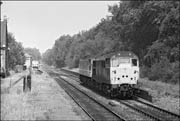 |
The sun wasn't quite round far enough when I arrived at Sutton Park on 13 July 1990 but I didn't want to miss this shot of 31348 dragging 47627 from Bescot to somewhere else - I have no idea where!
|
 |
One of my earliest shots with a medium format camera but with a waist-level rather than prism viewfinder which made framing a moving subject a bit tricky. The subject
is an unidentified class 31 passing Leamington Spa with southbound car carriers probably heading for the Cowley car plant in Oxford some time in 1987. The waiting passenger seems almost
determined not to look at the train.
|
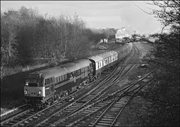 |
Steam-hauled charters ruuning in the winter months need some form of heating in the absence of stock from the times when the locomotive did the job. On 20 November 1999 a Stratford-upon-Avon to York special with 35005
on the front had 31452 on the back to provide ETH current seen here passing Whitacre Junction. The shot of Canadian Pacific was
a waste of film because the soft exhaust steam blew down in the chilly wind and obscured the train.
|
 |
When charter trains visited Stratford-upon-Avon prior to 1992 the locomotive that led the train into the station had to propel the stock out of the platforms
to enable a run-round or a second engine had to be sent from Saltley or Bescot to assist with the shunting. At the end of 1991 a locomotive release crossover and ground frame
were installed south of the Alcester Road bridge to avoid the former process. After the work was done 31522 and a short ballast train running as 8R01
were sent down on 13 December to drop the ballast on the new formation. The train was left by Stratford East signalbox and 31522
ran into the platform to run-round. It is shown here preparing to use the crossover just visible behind the locomotive before going to to another set of points ready to be positioned on the other end of its wagons.
|
 |
When the run-round and recoupling had been done at Stratford-upon-Avon on 13 December 1991 31522 propelled the short 8R01 into the station ready to drop ballast on the newly installed
locomotive release crossover south of the platforms. There was no Sunday passenger service in the winter at this time so there was no rush to get things done on this freezing afternoon...
|
 |
Not a shot for the light police but I wasn't going to miss getting a picture of the first train to go onto the new formation south of Stratford-upon-Avon on 1 December 1991. Ballast train 8R01
headed by 31522 was drawing forward at a crawling pace as ballast was laid on the new pointwork just about where Stratford West signalbox and a long refuge siding used to be sited.
|
 |
There was just time for a quick dash back onto platform 2 at Stratford-upon-Avon on 13 December 1991 for a final shot of 31522 and 8R01 as it left
the station for Bescot. The light levels were really low by this time and I had to use a shutter speed of 1/60 with an aperture of f1.8 on my Olympus OM1n
to get a just about acceptably exposed slide on Fuji 100.
|
 |
I don't always bother with a shot of light engine movements but four class 31s at Hatton on 18 March 1995 seemed worthwhile.
There was no information available about the train's origin or destination but it seems a reasonable bet that that 31453, 31532, 31514 and 31128
were on their way from Bescot to somewhere further south for a spell of weekend engineering work. I think that 31128 was the final clas member
to be active on the main line when I shot it south of Hatton on 3 May 1922 running from from Butterly MRC to Swanage
for some event or other on the preserved line.
|
 |
31106 and 31190 had been topping and tailing a radio reception testing coach, 977869, around Hampshire for the past few days and were scheduled to return from Eastleigh to Derby on Saturday 10 February 2007. The train, 2Z02, was some 3
hours late leaving Eastleigh but there was clearly a lot of recovery time in the original schedule as it passed me at Hatton at 14.09, probably only about one hour late
on the booked timings. Here is the train, led by 31106, crawling up Hatton Bank towards a red signal caused by the previous unit being an all stations local. There was a surprising amount of snow in the cutting, but it must be said that
I really don't like snow shots without the sun, unfortunately, it was too late to move to a clearer location where the snow might have thawed...
|
_10020.jpg) |
I'm not keen on going-away shots but did want a photograph of 31190 in its new coat of green paint. In the event, the sides of the locomotive were pretty grubby after running around for most of the week so the colour didn't show up too well. Just as the train passed under the
bridge at Hatton the signal cleared to yellow and the 31s were opened up prior to passing through the station, just around the curve in the background.
|
 |
I had just had my breakfast on the morning of Saturday 7 June 2008 when a text message from a friend living in Shirley arrived on my telephone. This said that 31190 + 31602 had just passed him, en-route to Stratford-upon-Avon with a single coach forming a 1Q16 Derby to Derby via Stratford, Hatton, Stratford, Henley-in-Arden, Birmingham, Stourbridge Junction, Round Oak, Birmingham, Hatton, Birmingham
and Derby. I received the message at 09.20 and had about 20 minutes to collect my thoughts, wits and camera to make the 10 minute walk down to the station. Stratford-upon-Avon isn't very good for photographs on a sunny morning but one has to make the best of a bad job and here is 31190 arriving in platform 1 with its short train.
|
_1Q16_SonA_070608.jpg) |
As I arrived at the station I remembered that it was the day of the third Open Day in recent times at Long Marston - there was quite a bunch of enthusiasts waiting for a bus shuttle to the event. The arrival of 1Q16 was an unexpected bonus for them and one or two are visible in this shot as 31602 tailed 31190 under the canopy in Stratford-upon-Avon station. Any locomotive-hauled train here is a rarity and I was pleased to have had the tip-off just
in time to get down to the station for a few record shots.
|
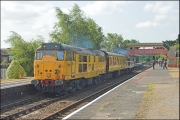 |
1Q16 was booked to stand in Stratford-upon-Avon for 10 minutes which gave the crew a chance to use the facilities and to buy a cup of coffee from the excellent station café. It also gave those heading to Long Marston the chance for some photographs before the train headed off to Hatton. Even though the sun was completely wrong for this shot, I decided to go part way along platform 2 for the departure as this gives a
view of the attractive infastructure of the GWR station, albeit with a decidedly non-standard, slightly pink footbridge!
|
 |
I had all too few trips to the Leicester area before the semaphores were abolished but have a good session on 18 August 1985 including some time spent at Wigston South Junction.
There wasn't a lot of traffic but one of the highlights was 31296 with a single van passing some nice upper-quadrant signals
just as the sun came out of increasingly bothersome cloud. The power-assisted distant arm was already being lowered as the train went uinder the roadbridge.
|
 |
While I was out and about on 12 October 2006, several messages came through saying that 31105 and 31106 were in charge of a 4Z07 10.00 Old Oak Common to Tyseley. I decided to delay my lunch and hang about for this. It soon became apparent that a delay was going to occur, as several northbound units passed at snail's pace and I was told that the passengers from a
Marylebone to Stratford-upon-Avon were detrained and told to await a replacement bus service. After about an hour, an S & T gang appeared and set to work on some of the trackside equipment. After another hour or so, trains began to move
again and 4E44, the 09.29 Southampton to Leeds Freightliner, which had been sitting in Hatton's down goods loop for the thick end of 2 hours, slowly made its way around the curve and on towards Birmingham. 4Z07 came shortly afterwards just after the light had just about caved in.
|
 |
The morning of 22 December 2009 in Stratford-upon-Avon started off with low temperatures, icy roads and worst of all freezing fog. This was a bit of a shame as a Tyseley to Derby via Stratford with top-and-tail class 31s were booked to come here twice in the space of not much
more than an hour. I was in two minds whether to bother going out or not but decided that a short trip to Stratford station might be worth while where a photograph would at least have a solid background, essential in foggy conditions. A friend travelling to Birmingham 'phoned
me from somewhere near Shirley as 1Q12 passed his train, incidentally in bright sunshine. The test train was due to at Sratford at 09.42 but it was seven or eight minutes late when it appeared through the fog and came to a stand in platform 1 with 31602 leading a single coach and
31601.
|
 |
The 09.07 from Tyseley to Derby via Stratford-upon-Avon is here seen in platform 1 at Stratford-upon-Avon with green liveried 31601 about to lead the short ensemble away from the station and off towards Hatton where it was booked to reverse and return to Stratford before going back towards
the West Midlands via the North Warwickshire Line. The train had arrived here seven or eight minutes late, but with a ten minute break booked was spot on time leaving. The temperature was hovering around zero degrees celsius and the remaining snow and frost wasn't shifting at all, but the
fog was beginning to thin a little by the time 1Q12 left the oddly coloured Great Western footbridge behind.
|
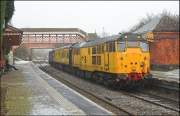 |
As I mentioned above, 30601 + 31602 were due to make two visits to Stratford-upon-Avon on 22 December 2009. Here is 31602 leading 1Q13 through a misty Wilmcote station after running both ways along the single track between Bearley Junction and Hatton. A solitary passenger is waiting for the 10.27
from Stratford to Stourbridge Junction which, if 1Q12 had been running late, might have blocked this shot. Fortunately though, it was on time and came quietly out of the mist just as a very weak sun appeared for a few seconds and gave a touch of illumination to the front of 31602. New station signs
had been erected here by London Midland, and here is an example showing that the new operators of the station have taken some trouble to keep the size and shape of the new signs consistent with the older versions.
|
 |
During their second visit to Stratford-upon-Avon on 22 December 2009, 31601 + 31602 had their ten minute break at the station before returning north and on to Birmingham via Henley-in-Arden. The light at was so poor that I really couldn't be bothered to move any further than the other
platform at Wilmcote station to get a final shot before returning home. Here then is 31601 in its relatively new green paintwork leading the short formation of 1Q12 under the Great Western footbridge just as a shaft of sunlight broke through the fog and did its best to ruin the picture; it was
just above the footbridge and shining straight into the lens. I said it before, but I do wish that London Midland would buy a few pots of paint and return the footbridges along this line to the Great Western's colour scheme of chocolate and cream. I had hoped that it would have been done to mark 2010, the 175th
anniversary of the company's inauguration...
|
 |
In the spring of 1993 there were four weekends of engineering work on the North Warwickshire Line. All the trains were run with double-headed class 31s
and had to run-round in Stratford-upon-Avon station giving some good photo opportunities. On 25 March 31524 + 31546 were at work and when I arrived
at Stratford East signalbox the locomotives were being uncoupled from their spoil train ready to run forward to the crossover between the inner and outer home signals. The signalman, Mick,
was not happy with the state of the points and locks and suggested that I should keep out of the way in case the train came off the road and said that the bracket signal would be a good bet.
Here are the class 31s running forward and about to cross to the down road where the train was waiting.
|
 |
After several minutes of watching point rods moving to and fro Mick had to walk from the signalbox and give the mechanism a good kicking
and put a manual point lock in place and having done so was able to get the ground signal clear. Here is the train with 31546 + 31524 crawling over the crossover on its way to Bescot without any incident.
In retrospect the signal probably wasn't the best place to be in the case of a derailment and I thought that Mick was after a picture from up there for his own collection!
|
 |
Before the next weekend engineering train at Stratford-upon-Avon on Sunday 18 April 1993 the S & T department had been along and fixed the problems with the
crossover and applied lots of grease to help smooth running. Here are 31533 + 186 using the pointwork to cross to the down line to collect the spoil wagons waiting in the station.
|
 |
After about 10 minutes 31533 + 31186 were back on the rejuvenated crossover and leaving Stratford upon Avon for Bescot. Virtually all the infrastructure in this picture
has gone including my perch for the previous train, the gas-holders, signal box and the tall aluminium chimneys from the demolished
food canning factory. The bracket signal once had 3 arms, the middle one for the Down Goods Loop and the smallest for the goods yard.
|
 |
For the third spoil train on the North Warwickshire Line which ran on 4 May 1993 I went to the roadbridge at Bishopton ready for 31112 + 31453 about to climb Wilmcote Bank.
The bridge has now been rebuilt with high parapets, the undergrowth has increased a huge amount and the fields on both sides covered
with offices (right) and housing (left).
|
 |
The last of the four engineering trains around Stratford-upon-Avon ran on 15 May 1993 and was the only one not to return to Bescot in dark and gloomy weather.
As it was sunny I went to Wilmcote station where the sun would be high enough for most shadows to be clear of the line. On this occasion 31105 + 31107 were allocated
and passed the station at 08.45 with their train of spoil.
|
 |
Another shot from Wilmcote, this time on a wet 24 February 1996, with 31439 going towards Stratford-upon-Avon with a 1T70, 07.38 Preston to Stratford railtour.
The train was at Stratford for about 45 minutes during which time 37207 was added once 31439 had run round the stock. This gave plenty of time to drive to the tall bridge at Shrewley, just to the north of Hatton North Junction,
for a picture of the unusual pair in torrential rain.
|
 |
A bit further from home on 10 March 1995 for this picture of another class 31 in dire conditions. Here, 31454 was about to pass Moira Junction signalbox with a Bescot to Barton train for loading at the quarry although strangely some of the larger wagons were not empty. The subsidence due to coal mining in the area
can be clearly seen beyond the junction for the Rawdon Colliery branch. A few seconds after taking the picture of 31454 a loaded ballast train headed by 47550 stopped at the signalbox giving just enough time to put a 210mm lens on my Mamiya 645
for a close-up shot of the trains passing.
|
 |
Back to Stratford-upon-Avon for a view of 31105 against the buffer stops in platform 2 on 7 July 1990. There was a charter using the Pilkington "K" stock and 47436 due to arrive from
Southport and the class 31 had been sent from Bescot to perform the shunt between platforms 1 and 2. This locomotive has arrived at Straford a few times over the years and on 28 October 2008 visited the terminus with the Structure Gauging Train, running as 1Q06, seen here just before departure for Derby RTC.
|
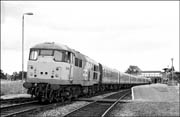 |
Next is a shot of 31105 after being coupled to the Pilkington "K" set in platform 1 at Stratford-upon-Avon on 7 July 1990 just before
it pulled the stock out with 47436 left in the platform ready to run forward once the class 31 had propelled the set into platform 2. These were the days when the station was well staffed
with staff qualified and able to couple and uncouple stock. This picture shows Aubrey Wheeler posing for a shot after he had uncoupled 31105 following the shunt. and
then attaching 47436 ready for the return journey to Southport with a class 116 on a service to Birmingham Moor Street alongside in platform 1.
|
 |
There have long been what some of us still call departmental trains between Bescot and Toton. This short example hauled by 31403 was pictured at Lea Marston on the morning
of 26 March 1993. It is always a matter of doubt whether this sort of train will run via the fast lines as seen here, or the slow lines via Whitacre Junction and it is often a matter
of some frustration when freights appear and disappear in the distance when standing at Lea Marston, but you pays your money and you takes your choice...
|
 |
A railtour, The Brentford Bard, visited Stratford-upon-Avon on 1 June 1991 with class 37s 37682 + 37685 as the main locomotives.
The train stayed for only about 30 minutes and 31403 was sent from Bescot to do the shunt move between platforms. It's seen here in platform 2 as 150110 left platform 1
with the 10.12 to Leamington Spa.
|
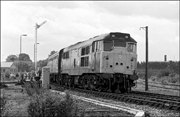 |
As soon as the railtour with 37682 + 37685 had come to a halt at Stratford-upon-Avon on 1 June 1991 31403 moved onto the stock to
draw the stock forward so that the class 37s could be released for their run-round. My old friend Aubrey Wheeler, in the hi-vis, was on duty to do the uncoupling and coupling
and he asked me to get him a picture as the train pulled forward. The class 37s were soon attached to the front of their train now in platform 2
so I went to the signalbox for a shot as they departed.
|
 |
There was a lot of variety in the freight traffic to be found at Derby in 1986 and I had a couple of sessions there in June of that year.
Unlike in 2023 there were plenty of smaller locomotives to be photographed on a variety of trains and this is 31280 with a short p-way working
towards the station and yard area.
|
 |
A few minutes after I took the picture of 31280 at Derby shown above another class 31 went in the opposite direction with a set of Civil Engineer low sided wagons.
The famed Derby Works is prominent in the background with its clock tower covered in scaffolding and undergoing some work. A Matisa Neptune Track Recording machine
is just visible behind the second wagon and of which I took a closer view on the following day.
|
 |
A touch of brightness appeared at Hatton in July 1991 as 31145 went down Hatton Bank with a short train of mixed wagon types from Bescot
going to Didcot.
|
 |
A rake of Mk2 coaching stock has been trying to escape from Long Marston for a couple of weeks but for various reasons apparently revolving around school holidays and
unavailable locomotives, it didn't happen until 9 November 2009. The motive power on the day changed from 47812 to 31190, the green liveried locomotive running light diesel
from Washwood Heath to collect the coaches. An early departure from Long Marston took place but the train, 5Z47 to Barrow Hill, had to stand time on the former East Loop
at Honeybourne until both an up and a down train had passed and cleared the single line between Moreton in Marsh and Evesham.
Here, 31190 and the six coaches stand on the loop from Long Marston in quite dark and misty conditions, the Cotswold Hills being virtually obscured by the murk.
|
 |
As soon as the HST shown in the linked picture above had reached Evesham it was possible for a crew member from 31190 to insert the key in the ground frame at Honeybourne switch the points and call
5Z47 to come over the spur and onto the Cotswold Line spot on time at 13.25. The train was then to run via Evesham, Worcester, Droitwich Spa and the Lickey Incline to Birmingham and on to its
destination at Barrow Hill. This shot will not be possible by this time next year when the Cotswold Line receives double track as trains from Long Marston will run on the tracks on the extreme
left of this picture past the platforms at Honeybourne station and join the main line just south of the platforms.
|
 |
Class 31 hauled trains between Birmingham and Norwich were coming to an end in May 1988 and I few trips out to take some final shots. This image shows 31460
passing Washwood Heath yard on 14 May 1988 with the usual 6 coaches not long after leaving Birmingham New Street.
|
 |
Later on 14 May 1988 I had moved towards Birmingham further along Washwood Heath yard in an area that at the time was little more than unfenced waste ground. There were several mounds of soil some of which made decent perches from which to photographpassing traffic including
31460 on the final stage of its 4 hour journey from Norwich.
|
 |
An unidentified class 31/4 was passing the foot crossing on the Leicester line near Water Orton station on 13 May 1988 for this shot shortly before the class ceased working on Birmingham to Norwich trains.
It's a bit of a bland location but the line was mostly clear of shadows and made a good spot to hear the small locomotives working hard to accelerate their trains up to line speed. The haze of exhaust smoke
gives an an idea that full power had been applied once clear of the pointwork at Water Orton.
|
 |
There should have been a train to Long Marston from Derby Engineers Sidings on Tuesday 29 January 2008, but this was cancelled during the morning. Instead, 31454 was sent light diesel from Gloucester as 0Z67 to pick up something and take it back to Gloucester. I went across to the Long Marston site to see a rake of 7 InterCity MkII coaches
waiting in the exchange sidings and thought that a nice picture of a complete IC train was going to be a distinct possiblity. Here is 31454 just after arrival awaiting instructions and permission to enter the sidings.
|
 |
As far as I am aware, 31454 is the first InterCity liveried locomotive to have entered the yard at Long Marston under its own power, and it's always nice to get a record of something new on one's favourite patch. The booked departure time was 14.55 but the train, now running as 5Z68, started to move along the exchange sidings at just after 13.30.
Here it is, complete with the 7 MkIIs, as it heads towards the "One Train Only" branch to Honeybourne, running alongside some of the recently arrived ferrywagons which came in a couple of weeks ago.
|
 |
I just had time to switch lenses from my long telephoto to something a little shorter before 31454 joined the branch. The sun had been shining a short while before 5Z68 moved but dipped behind a thick layer of grey cloud just at the wrong time. Still, the uniform appearance of the locomotive and coaches is aesthetically pleasing and a sight not seen for some time.
|
 |
My usual move after Long Marston is the quick dash to Honeybourne to photograph the train arriving at the end of the former East Loop. Today though, I had planned on going somewhere for a change, but found the entrance gated and locked. In the event, things turned out quite well because 5Z68's driver brought his train forward beyond the spur to the main line to give his
colleague a shorter walk to the ground frame where the telephone and block instruments are kept. This is an unusual move and I wonder if it was to save time because there was only available a limited amount of time to get through the single track section to the passing loop at Evesham station. Whatever the reason, it was good to record the move; it is strange how these little things
can make a difference to the session.
|
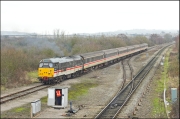 |
I couldn't resist including this shot showing 31454 chucking out some black exhaust as it propelled the stock back towards the point giving access to spur across to the main line. The driver's colleague has just obtained clearance to put the token into the ground frame, which will be released by Evesham
signalbox, and within a few seconds operated the levers and signalled 5Z68 to come forward.
|
 |
Here is my final shot of the day as 31454 brings its 7 MkIIs across the spur and joins the main line to Evesham, before heading off to Worcester for a run-round and going back to Gloucester. It would be an understatemment to say that the train made a spirited departure from Honeybourne - I haven't a 31 make such a racket for years - and it
was audible for ages as it went away. I believe that the coaches are destined for Meldon Quarry and will be taken there tomorrow, 30 January 2008.
|
 |
A convoy of preserved locomotives led by 31128, the only class member registered for main line use, ran from Butterly MRC to Swanage on Tuesday 3 May 2022 presumably to take
part in a special event. I opted to take a shot or two of this rather than of 37800 (again!) on a class 196 drag from Tyseley to Long Marston and went to a footbridge at the southern end of Hatton Cutting
where the image is taken on the inside of a gentle curve to better show the locomotives being towed along. Although the light was poor the blue quartet showed up well amongst the light green background
with 31128 conveying 37067, class 44 D4, and class 46 D182.
|
 |
I made a few trips to Bescot in the 1980s at a time when there was a large amount of freight either passing through the station or starting and terminating in the yards.
On Friday 27 February 1986 there had been an overnight snowfall which enhanced the less than attractive architecture of Bescot station. It was usual on a Friday to
see a lot of light engine moves as locomotives returned to the depot for the weekend and this pair, 31289 + 31285 were on their way to the holding sidings.
|
 |
This and the following 2 photographs were taken at Reading on 6 March 1985. Here, 31450 has made its stop in the platform while working a morning Hereford to Paddington service formed of 5 coaches.
The class 47 is waiting for the next inter-regional train wokring to Poole, the majority of which called here and reversed with either a fresh locomotive or a run-round of that which worked the incoming service.
|
 |
Next along at Reading on 6 March 1985 was 31304 with a set of flats which I imagine were used for MOD traffic and were being taken to Didcot where such trains were staged and re-marshalled.
|
 |
Later in the day at Reading on 6 March 1985 I took this shot of 31450 with a pair of NPCCS vehicles. Without any local gen or a WTT/STN it
was impossible to identify the working. The end of the Waterloo platform at Reading was an excellent photo spot at this time, especially in the afternoon for any
westbound trains, with clear views of all lines and a nicely industrial backdrop.
|
 |
A truly dreadful quality image but with some historical interest. It shows 31106 just about to reach the summit of Hatton Bank in shocking weather on 4 April 1985 with no fewer than 13 vans in tow.
I don't remember it now but can imagine that this load coupled with the 1/110 gradient of the bank would have made the locomotive cough a bit, especially on a wet rail. In much better conditions
and with a fresh coat of blue paint 31106 was still around and working test trains on 12 September 2011 as this image from Honeybourne shows. It had previously
carried Network Rail yellow livery and the "Dutch" Civil Engineers colours.
|
 |
The May timetable of 1988 saw the first scheduled HST working to Stratford-upon-Avon when a mid-morning departure from London Paddington arrived
which then formed an afternoon return to the capital. To check clearances for the Mk3 stock a gauging train formed of 31237 + coach 19173 was sent to Stratford on 14 October 1986 and
I assume that it ran so far in advance of the first HST working in case any work on the platforms was needed. It wasn't an especially high-tech event with just visual checks
on all 3 platforms being carried by a couple of men on the train. I never did find out the headcode but here is 31237 in P1 after arrival and a run-round in the Down Goods Loop
prior to making 2 more trips to the crossovers outside the station and checking platforms 2 & 3.
|
_19173_SonA_141087) |
I reeled off a stack of pictures of 31237 at various stages in the clearance checking process at Stratford-upon-Avon on 14 October 1987 but
won't upload too many as they are probably of little interest to non-locals. The first HST from Paddington to Stratford ran on
16 May 1988 but the late morning arrival on a sunny day made for tricky lighting conditions. Here is one effort from the Alcester Road overbridge as the train arrived
to be met by just 2 photographers such was the lack of interest in the type in those days.
|
 |
A time of transition at Leicester. The attractive and charismatic semaphore signals were not long for this world on 25 May 1986 as the multiple-aspect
replacement for the platform-end signals shows. Approaching the station is 31126 with what my notes say is the 08.12 Cambridge to Birmingham and I take this to be
correct as I rarely noted details of workings in those days so must have been told by someone who knew. I do know that the locomotive is 31126 which along with the 2 coaches
formed a DMU replacement. The livery carried by 31126 was relatively new at the time and here is a shot taken at Guide Bridge
on 2 May 1984 when it still carried BR blue.
|
 |
The first of 2 photographs from Nottingham taken on 18 May 1991. This one shows 31410 just to the East of Lenton Junctions and on the way to Nottingham station with a mixed set of NPCCS including a couple of red Royal Mail vehicles working towards the station.
In the background is a disused yard with what appears to be a single track left in place along with a goods platform and canopy.
|
 |
This picture was taken from the same spot as the one above but with an 85mm lens rather than a 50mm version on my Olympus OM1n. The train is a Kingsbury to Humber empty oil
working with 31255 + 31180 providing the power. Class 60s were not far away by this time and would soon take over these heavy trains from pairs of class 31s and indeed in 2021
the bigger locomotives still operate on them.
|
 |
Oops! Class 31/4 31457 was off the road at Reading on 14 May 1988 with a breakdown crane in attendance and with what i tale to be jacking points
fixed to the bogies. The position of the locomotive looks a bit dodgy as there seems to be quite a drop to the left of the line judging by the rooflines of the industrial units. 645
|
 |
Class 31s have been very much part of the U.K. railway scene for many years although in 2021 just one example, 31128, is allowed onto the main line.
They were never the strongest engines and their adhesive qualities were not helped by the A1A wheel arrangement which meant that some of the loco's weight was borne on
unpowered wheels. Nevertheless, they did a lot of valuable work both on passenger and freight trains and had a particularly pleasant and rasping exhaust note, especially when being worked
hard. This picture, taken on 16 February 1994 shows 31178 at Barrow-on-Trent with a Bescot - Toton departmental.645
|
_pilot_bns_15789) |
For many years it was the practice to have a spare locomotive stabled on a through road at Birmingham New Street to provide cover in case of a failure or to do a bit of shunting,
perhaps with a Royal Mail train. On 15 July 1989 31414 was on duty and although I don't often take portrait pictures of static subjects this one
was hard to resist as it stood 645 with 85037 which was unfortunately mostly in shadow.
|
 |
Another place where I took a few locomotive portaits was Manchester Victoria where in the 1980s there was always an engine or two ready to bank heavy
eastbound freights up the still climb to Miles Platform. I can't find a note of the numbers of this pair of class 31s waiting for their next job nor that
of the class 45 with a Liverpool to York or Newcastle service waiting for its departure time but guess that it was probably sometime in 1987. A single class 25
was often found to be doing this job and it's quite probable that the adhesion of the nominally less powerful locomotive would make it superior for this work than a single class 31.
|
 |
The suburban passenger service in the West Midlands was branded "Midline" in the late 1980s and on 23 April 1988 a Midline Day was held with a display of locomotives at the recently reopened Birmingham Snow Hill
station, a visit from the Hastings DEMU which worked Leamington Spa to Stratford-upon-Avon trains and various other attractions. This locomotive, 31413, had just been been
repainted into a slightly bizarre colour scheme and had worked into Snow Hill hauling a selection of stock including 40122, the last class 40 still operational on the main line.
This was carrying a headboard (in April) apparently advertising a Christmas event...
|
 |
It wasn't just steam locomotives that worked the Sunday Luncheon Expresses dining trains into Stratford-upon-Avon from London Marylebone. It was discovered that using a diesel from Banbury to Stratford saved enough
coal to avoid having to rstock the tender at the terminus; a messy and hard job for all concerned. On an extremely dull, cold and wet Sunday in 1987 a class 31/4 did the job along with ETHEL 2 (97252) providing power for
the train and such was the weather and general lack of interest from photographers that I was the only one here. There was quite a bit of shunting involved to get the ETHEL on the front of the train ready to be coupled to whatever
steam locomotive was on duty and this gave the chance for a picture of what appeared to be class 25 hauling a passenger train out of the Down Goods Loop, the class 31 being out of sight pushing the stock
back into platform 1.
|
 |
Another class 31 to visit Stratford-upon-Avon was 31112 some time in 1986 on another dull and gloomy Sunday. It's seen here just after arriving in platform 1 with a short ballast and spoil train from Bescot
after some work on the North Warwickshire Line. The train as about to be propelled into the Down Goods Loop and the ground signal can just be made out along with the shunter. Stratford didn't have any Sunday trains at this time in the winter so there were no issues with the engineering train avoiding other services.
|
 |
Stratford's Down Goods Loop wasn't much used once steam had finished as there was clearly no need for the water crane and what little freight remained on the line before it was truncated in 1976 passed straight through the station.
It was always therefore worth a shot on the occasions when anything went in there as 31112 did in order to run-round its ballast and spoil train in 1986. The upper quadrant signal in the background
was the least used of any in the station area along with the corresponding one shown here which controlled the entrance to the loop. The class 31 ran into platform 1, reversed, re-entered the loop
from the north end and then propelled its train into platform 1 as can be seen below.
|
_SonA_1986) |
Once 31112's train was in platform 1 at Stratford it would have been able to leave for the return journey to Bescot. When I took this shot the points from the loop hadn't been changed back for the main down line nor had the ground signal been cleared. I seem to recall that the crew had a break
for a while before setting off and that it was too cold and dull to hang around any longer.
|
 |
The class 101 DMMU known as Iris was taken from Derby to Bishops Lydeard on Tuesday 18 March 2008. The power provided was 31459 which, in its black livery, provided a nice contrast to the two different yellows of the unit. I wanted to be in the Evesham or Pershore area at some point during the day so just went to
the nearest point to my home where a reasonably wide view could be obtained so as to show all 3 vehicles. Here is 5Z08 passing Croome Perry wood after being in the loop at Abbotswood for some time to allow the passage of a class 170 on a Cardiff service and an Arriva Voyager on a Cross Country train.
|
 |
The footbridge at Portway, near Elford, is a decent enough and pleasantly quiet spot for afternoon photography although the high-tension wires are a bit distracting. This picture
shows 31308 hauling a Bescot-bound ballast on a beautifully sunny 25 October 1993.
|
 |
Another photograph of a class 31 hauled departmental, this time the morning Bescot to Toton train, shows 31106 on the Castle Donnington line. It has just left the main Birmingham to Derby line at Stenson Junction and will run along the freight line to Sheet Stores Junction. I've included this picture because of the filthy
state of the locomotive - very much the norm at the time, 2 March 1994.
|
 |
The Network Measurement Train running with power cars 43062 + 43154 failed in the Bristol area towards the end of the week ending 30 April 2005. NR's 31233 was depatched light diesel to Stoke Gifford to return
the train north but Network Rail then decided that a single 31 would not be allowed to work single-handed. 31285 was also sent south and the whole ensemble worked north in the early afternoon of Sunday 1 May.
The train, running as 5Z19, is pictured here at Defford being driven by Mike Jones who kindly gave me the details of the working. The sun wasn't fully out but at this time of day (13.31) on this line the backlighting would have been
rather harsh if it had. A video clip of the train can be found on the link.
|
_TDB975007_8_SonA) |
From the kitchen window of my then nearby home on a date I can't find in my notebooks but probably in 1985 I saw 31426 arrive at Stratford-upon-Avon with the Derby Lightweight Ultrasonic Test Train (TDB975007/8) in tow. It went into the Down Goods Loop where the class 31
was detached, ran along the up main line to the crossover before being coupled to 6Z08 and prepared to leave. Here, the second man watches the locomotive
approach along the by then rarely used loop which was taken out of use within a few weeks.
|
 |
It wasn't many minutes before 31426 was coupled to the Ultrasonic Test Train in Stratford-upon-Avon Down Goods Loop and a brake test carried out. After establishing that the crew
were OK with my crossing the line I moved to a mound of earth for a slightly higher viewpoint and took this picture as 6Z08 left the loop to use the crossover (which the signalman maintained wasn't fit to use!)
and joined the up main line towards Bearley Junction. The set has entered preservation and details can be found here
on the brilliant Railcar.co.uk website: essential viewing for anyone with an interest in first generation DMUs.
|
 |
On 13 July 2002 there was a Lramington Spa to Workington charter, 1Z31, with FM Rail's 31128 and 31459 providing. This isn't a great time for photography on the GWR line between Leamington and Birmingham
and I chose Lapworth station which at 07.25 in the morning was a bit on the shadowy side. It was too late to go anywhere else but at least there was a reasonably large gap into which the locomotives almost fitted.
|
 |
The footbridge just to the west of West Ealing station was a justly popular spot for railway photography for decades and I made several trips there in the late 1980s.
Among the large number of main line freight trains on 30 November 1989 there were a few trip workings incluing this one with 31125 taking fuel oil to Old Oak Common.
Itwas pictured taking the line towards Castle Bar Park and Greenford and will turn right ant tghe end of the branch before running alongside the LUL tracks at
Park Royal and on to Old Oak.
|
_ooc_tanks_301189) |
The fuel tanks to and from Old Oak were slip worked with the previous train and 31125 came back along the Greenford Loop later in the day on 30 November 1989.
The flats in the background were built on an extensive goods yard, sidings and a milk dock which received huge volumes of milk every day from across the West Country.
This picture from Wikipedia gives an idea
of the size of the site. The milk tanks had to be taken across all four main lines to the sidings and unloading facility on the extreme right of the picture; that must have given signallers
a pathing dilemma given that this was a extremely busy line.
|
 |
In 1989 it was commonplace to see small locomotives such as class 31s working quite heavy trains. This picture taken at Barnetby on 13 January 1990 shows
31203 taking a heavy train of steel for export from Scunthorpe to Imminham Docks, This was a regular trip and I saw the same locomotive several times during the day either running
light engine back to Scunthorpe or returning to the docks with another load. One of the main attractions here was the array of semaphore signals, now gone, not to mention the quantity
of freight to photograph hauled by a good variety of motive power.
|
 |
The view from the eastern end of Barnetby station gave a shot of Barnetby Station signalbox along with more semaphores. A Humber Refinery to Kingsbury train of loaded tanks
hauled by 31156 + 31289 just catches the early morning sun on 13 January 1990 as it passed the'box with the heavy frost yet to disappear from the sleepers.
|
 |
Once the sun was high enough to clear the lineside trees on 13 January 1990 a move was made to New Barnetby to vary the pictures a bit. This is another of the Scunthorpe to Immingham Docks steel trip workings with 31203
pictured accelerating away from Barbetby station. The view in this direction isn't seen as often as the one looking east and it must be said that the more open
view with some background interest is more appealing.
|
 |
In 1989 several summer-dated holiday locomotive-hauled trains ran from the timetable change in May. In this area there were several booked for class 31 power including the one pictured from Leeds to Tenby. Unusually, on 15 July, it
ran with a single locomotive, instead of the booked pair. The singleton was 31405 and is seen passing Northfield, Birmingham. In the course of less than 2 hours, no fewer than than 8 loco-hauled passenger trains passed this spot, along with
a police car called by a worried local inhabitant who thought I was a likely candidate for suicide by jumping off the bridge onto the railway line. Suicidal with sunshine and all these trains?!
|
 |
A short while after the train shown above had passed Northfield on 15 July 1989 the SO Leeds to Paignton came along with 31408 + 31455 providing the power. I haven't been to this location for a long
time but with the advent of ovehead electrification to Redditch and Bromsgrove and the usual rampant and unchecked growth of lineside vegetation I doubt that there is much of a shot in 2021.
|
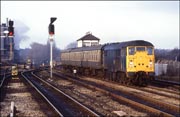 |
In the winter of 1984/85 there was a spate of crew training runs between Birmingham and Banbury. These employed any old locomotive lying around Bescot including classes 20, 31, 37, 40, 45 and 47 and on
22 January 1985 31134 with 3 grubby Mk1 coaches was provided. The ensemble in seen here about to pass through Leamington Spa on the up main line. The GWR North Signalbox was still in use at the time and the Ford
factory with its own foundry was still operative on the down side of the line. This site is now a supermarket. Of course.
|
 |
The field adjacent to the Derby main line at Water Orton was a good spot to photograph a bunch of locomotive-hauled passenger and freight traffic, even on Saturdays, in 1988.
This picture shows an almost ex-works 31186 taking a set of MGR HAAs from Bescot to Burton-on-Trent on 11 January 1988. This is another spot I haven't visited for a while
but I can't imagine that the tatty post and wire fence with convenient gaps is still there which allowed access to a small hump in the grass giving a useful foot or two of extra height. 645
|
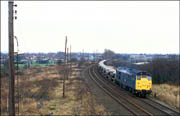 |
This picture doesn't feature in my notebooks so I can't quote the locomotive number or the date on which it was taken. I do know that the train is a Croft Quarry to Bescot
loaded ballast and that it was taken from the footbridge over the flyover line at Nuneaton which allowed freights to avoid having to cross all 4 lines of the West Coast Main Line.
The line and its surroundings were full of character and the abandoned sidings show that it once was once a busy spot and once that I should have liked to have visited in earlier
times. My only other trip there was to photograph an unusual locomotive-hauled passenger train on 23 September 1989 when 47973 on a Pathfinder special running
from Swindon to Middleton Towers which this locomotive hauled from Birmingham New Street to Melton Mowbray. If anything, the backdrop to this picture, Hatshill Quarry, is even better than that in the picture
of the ballast train, apart maybe from the skips...
|
 |
On 14 May 1994 A1A Charters ran a railtour from Preston to Weymouth Quay. Part of the itinerary unsurprisingly included a pair of 31s, one of which was a coal sector locomotive. This was pleasing from a photographic point of view
as these locos were rare on passenger turns. The train is seen here passing Ashchurch at 09.48.
|
 |
The nearest to a freight train the Stratford-upon-Avon line ever sees is the occasional engineering working which uses Stratford station's run-round facilities. In this picture, 31105+31107 and their now-empty train of
ballast hoppers have finished work, run-round and are heading back to Bescot. They are seen passing the attractive GWR station at Wilmcote, the first out of Stratford-upon-Avon at shortly after 8am on Sunday 15 May 1993.
|
 |
Another engineering train is seen here in the Down Goods Loop at Stratford-upon-Avon on Sunday 10 January 1988 with 31257. This location would be unrecognisable in 2020 and the line and associated
signalling including the East 'Box have gone, the gasholders have been demolished and the chimneys of Stratford-upon-Avon Canners have gone along with their factory. The OTP involved in the work can just be seen alongside
the signal box.
|
 |
Later in the day on 10 January 1988 the engineering work had been completed and 31257 had been run-round its train ready for departure to Bescot. I was fortunate in that
I knew the signaller well and with the line closed to passenger traffic was allowed free change to wander around wherever I wanted. The sun came out as the train began to
reverse from the loop into platform 1 at the station so that it could leave on the up main.
|
 |
It didn't take long for 31257 to complete its movements and it was soon on the way back to Bescot on 10 January 1988. This shot was taken by standing on the point rodding
just to give a little extra height and with the well-known gasholders forming the backdrop. The OTP, which I think was a TRAMM, followed under its own power as soon as
the preceding train had reached the end of the signalling section, Bearley Junction.
|
 |
I was surprised to find a pair of 31s on this short ballast train from Bescot to Gloucester on 30 May 1997 as they were not all that active by this time. The train, hauled by 31450+31306, is pictured passing the site of Defford station on the
Birmingham to Cheltenham line. The locos returned north light engine a couple of hours later.
|
 |
The annual Motor Show at the NEC in Birmingham used to attract several dedicated trains from various parts on the country. On 26 September 1990 one of the specials was hauled by 31403+31423 which after dropping off its passengers ran from Birmingham International to Leamington Spa in order for the
locomotives to run-round before heading north to Oxley for servicing. This ECS is pictured here climbing Hatton Bank at 11.45, just about catching the sun.
|
 |
In the summer timetable of 1993 a Birmingham New Street to Pwllheli train ran and was booked for a pair of 31s. The ECS ran from Tyseley and this working is pictured above at Bordesley Junction on 22 May 1993
behind 31166 + 31146.
|
 |
31249 is shown below passing Leamington Spa on 21 December 1984 hauling a rake of pressurised gas tanks from Bromford Bridge to Fawley. The signal box behind the tanks was demolished shortly after
the date of this picture. I don't imagine that the class 31 worked this train throughout and it was probably swapped at Banbury or Didcot. Today, a train like this would never be entrusted to such a small engine (even if there were any) and would
certainly be in the hands of a 66.
|
 |
Pictures of tube stock at Leamington Spa have been ten-a-penny in the years between 2010 and 2020 but there were fewer taken in 1984 when the
occasional train ran. This one shows 31198 passing the station on 21 December 1984 with 31198 providing the power. Brake vans were used as barriers
and for brake force in those days; a more attractive photographic subject than the bogie tanks used today.
|
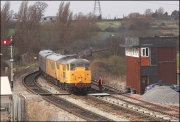 |
Thursday 30 March saw a then rare locomotive-hauled move booked through Evesham in Worcestershire, a 4Z07 Derby to Old Oak Common with 31105 and 31106. The train is seen here at Evesham signal box, the token having just been exchanged after
traversing the single line from Norton Junction. The tiny patch of sun just caught the Network Rail locomotive nicely.
|
_4z08_evesham_0306.jpg) |
The patch of sun mentioned above didn't last long enough to illuminate 4Z07 as it slowly pulls forward towards Evesham station where it will wait for a few minutes to
allow a Turbo to clear the track from the south. The stop just gave me time to swap my long zoom lens for a wider angle version to get this shot passing the peg. I always think the bracket signal looks a bit lop-sided and sad, having lost 2 arms some years ago.
|
 |
In 1998 the field to the north of Water Orton was an easy and quite decent location for traffic on the Derby fast lines. On Saturday 6 February 1988 I went
there just to photograph anything that came and was happy enough when 31121 came south with a freightliner train which after checking the WTT found was a Leeds to
Rugby via Bescot service. For some reason I took this shot in vertical format and have cropped the medium format slide to produce a landscape format better
for this purpose. 645
|
 |
The long reign of class 31 on Birmingham to Norwich was due to come to an end in 1988. This shot was taken on 14 November 1987 from the convenient
mound of ballast alongside the line at Water Orton. Access was through the gate on the extreme right and this was usually open and always left unlocked
and therefore much used by photographers. 645
|
 |
The mound of ballast (and the open gate) mentioned above are clearly visible in this view as an unidentified class 31/4 leads the 12.20 Birmingham
to Norwich service through Water Orton on 14 November 1987. I can't imagine that the advent of sprinters on thses trains was exactly welcomed by passengers
and it's almost certainly true that the railway's revenue from them dropped once enthusiasts stopped travelling. 645
|
 |
This photograph of 31468 on a Norwich to Birmingham New Street train was taken at Bromford Bridge on 14 May 1988, just before the class finished working these diagrams.
This was another picture taken in vertical format in order to show the River Tame in the foreground but I have cropped it in order to better fit on this page. 645
|
 |
Towards the end of class 25's working life 31s were to found covering the some of the trip freights from Bescot, including T48 covering Langley Green, Rood End yard and the Handsworth terminals. Here, 31132 is returning from Albright & Wilson's works at Langley Green in the Black Country on 3 October 1986 with 6T48. This is one of the very few photographs I managed
here in anything but poor light and could hardly believe my eyes when the sun broke out as the train appeared on the curve with empty chlorine tankers. The landscape here has changed dramatically since 1986 and much of the industrial infrastructure has disappeared much
to the downturn in its attraction for photography.
|
 |
After taking the photograph of 6T48 shown above, there was time for a quick trip to the road bridge at the other end of Langley Green yard to get this shot of 31132 coming slowly down the up loop line before rejoining
the main line. I haven't been back here for years but I do know that the semaphore signals have gone and that the yard and most of the adjacent factories have gone.
|
_eagle_xing_16687.jpg) |
Here's an unrepeatable shot. 31142 runs over Eagle Crossing box on the now-closed line from Stourbridge Junction to Bescot on 16 June 1987. The train, Bescot's 6T42, comprised a rake of freightliner flats which I imagine came from the terminal at Dudley.
Sadly, this was my only visit to this location and it had to be on a day characterised by dreadful weather, but at least I did record the scene before it all went. Even should the line re-open in the future, the Black Country landscape will have changed and, of course, the signalbox and all the railway infrastructure will have long gone.
|
 |
I spent a couple of hours during Monday 15 June 1987 on a road bridge just to the north of Acocks Green station on the GWR Leamington Spa to Birmingham line. Something must have been going on on the Coventry line
because I saw several diverted locomotive-hauled InterCity trains along with quite a variety of freights. One of the more interesting trains photographed was the Chipmans weedkiller hauled by 31127 shown heading towards Tyseley.
This section of the route used to be four-track north of Dorrdige and was heavily used in the days of steam and early diesels until much of the freight traffic was lost to road transport and a number of passenger routed elsewhere.
|
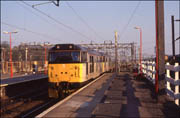 |
I had a day around Bletchley and the line from there to Bedford on 7 April 1990 with the intention of photographing some class 31s on the household and industrial waste traffic
going to and from Forders Sidings near the site of the brickworks, the worked-out clay pits of which were used as a landfill facility much in the style of Calvert. A few minutes after I arrived 31271+ 31294 arrived in the platform
line with empty wagons which had brought contaminated material from Chatham in Kent via Gillingham Yard. Not the best angle for a picture
but with such good light I wasn't going to turn it down.
|
 |
This picture was taken at Bletchley on Saturday 7 April 1990 a short while after the one above and shows 31415 propelling a short rake of vans into the yard. The train had just arrived from Bedford and was a regular weekend
working at the time. There were many of this sort of train all over the network in those days but all have now disappeared with the exception of a few EMUs used for postal traffic on the WCML.
|
 |
The really good early light on 7 April 1990 didn't last and by the time I arrived at Forders Sidings near Stewartby station on the line to Bedford there was lot of cloud around and the sun had moved around towards the West. This picture of
31301 + 31180 was taken from a level crossing with a train of household waste from Cricklewood and although there was a gantry of semaphore signals there I didn't have a sufficiently wide angle with me to include it in the picture. Here is another view of 31301 at Wilmcote
in the company of 25287 on 7 October 1984 and another on just about its final journey at Evesham on 19 December 2007 when en-route to Long Marston.
|
 |
Class 31 was a common sight around Birmingham in 1992 and on 13th May of that I spent a few hours at Whitacre Junction photographing 3 westbound workings all of which were either loaded or empty ballast trains routed along the goods loop.
This picture shows 31107 leaving the loop with a long set of low-sided wagons fronted with a brake van. I wasn't able to identify the originating point but assume that it was heading for Bescot Yard to be stabled.
|
 |
Unlike the train shown above I do know the origin of this train; it came from Croft quarry near Nuneaton and was headed by 31512 + 31158 both chucking out some smoke as the heavy train began the exit from the loop at Whitacre Junction and moved away towards Bescot.
The brace of OTP machines in the background had come from the Bescot direction, crossed over just out of sight around the corner and were working under permissive rules as they entered the loop prior to going back towards whence they had come.
|
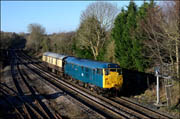 |
An empty stock move from Burton-on-Trent to Eastleigh was showing to run on Tuesday 3 December 2019 and the headcode, 5Z31, appeared to offer a clue to the motive power likely to be allocated.
After a session in the swimming pool at my gym I drive to Hatton which I knew would be one of the few spots reasonably clear of shadows at this time of the year where it was confirmed that 31128, the sole
main line certified class 31, was in charge of the train. I wouldn't usually bother with a load of a single coach, in this instance a Mk1 generator vehicle, but the combination of the locomotive and clear sunshine made it worthwhile. Here is 5Z31
approaching Hatton station at spot on right time and a few seconds before a Stratford-upon-Avon bound unit went around the curve on the branch. Those few seconds made all the difference as the unit cast a heavy shadow
from the low sun right across the up main line. I hadn't seen 31128 for a while but here it is at Long Marston on 27 February 2007 in its Fragonset colours and taking some barrier
coaches into the site for another move later in the day.
|
 |
I went to Manchester Victoria more than a few times in 1985/6. There was a convenient 08.05 HST from Birmingham New Street to Piccadilly which cost £7.25 return and very rarely had more than a handful of passengers aboard until the Stockport stop; indeed I sometimes had an entire carriage to myself
for most of the journey. From Victoria a 20p bus ride on the frequent Picc-Vic service made the rest of the trip very easy. On 27 February 1986 I was taking various shots on the old Exchange station, westbound trains being best photographed from the wrong side of the fence adjacent to the car park.
This view shows 31170 heading West with a long rake of various empty ballast wagons probably from Guide Bridge. A class 37's nose can just be seen in the background. This was 37122 on station pilot duties waiting for its next banking job for the climb up Miles Platting bank.
|
 |
Tuesday 25 July 2006 was the date picked for a trial run by FM Rail, conveying coal from Daw Mill Colliery to Rugeley Power Station. It was booked for class 31 traction, with no fewer than 3 examples being used. The train of PGA hoppers had a late start from Coalville and was arriving for
reversal in the loop at Whitacre Junction just as I arrived at 08.25. 31454 was at the front and here is something of a grab shot as it heads into the headshunt under the road bridge. 31601 + 31190 were at the other end. A hot box detector had been set off on the run from Nuneaton and examinations
were carried out while it was in the loop here. Fortunately, this didn't halt the run and the train eventually departed for the colliery at 09.40.
|
 |
Here is the shot of the FM Rail test working for which the gallery at Whitacre Junction had been waiting on 25 July 2006. 31190 + 31601 + 31454 take the 6G20 09.24, (rescheduled to be 13.00) Daw Mill Colliery to Rugeley Power Station through the junction at 12.43. The train was heavily delayed through a late
start from Mantle Lane, Coalville and hot box problems on some of the PGA stock, all of which were shown on TRUST as "cripples". Still, the ensemble makes for a
very pleasant and colourful sight, and the 3 hours spent waiting were filled both with some interesting workings and chat. For another view of this after reversal at Bescot, have a look at
Andy Williams' shot taken at Leamore, near Walsall later that day.
|
 |
This picture is dated Sunday 23 March 1986 and shows 31260 at Stratford-upon-Avon with a short engineering train including a crane which was to be used to lift some steel drain material from
an open wagon. The crane was self-propelled and at the point this picture was taken was crossing over to the up line by means of the very rarely-used crossover, shown in this picture, adjacent to the bracket signal
just outside the station. This and following 2 pictures were taken on a Praktica LTL3 SLR which although mechanically suspect had a very decent f2.8 lens.
|
 |
Here is a view of the crane itself, now on the up line, as it approaches the wagon containing the work materials and here is another shot showing the wagon along with 2 brake vans.
I am standing close to the Goods Loop which was still in occasional use at this time. By the time of the black & white image shown via the link in the previous caption it had been severed and was awaiting removal.
|
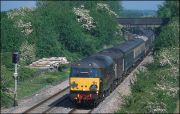 |
On Sunday 14 May 2000 a pair of Fragonset class 31s were booked to take the "Torbay Quarryman", running as 1Z36, from Crewe to Newton Abbott from whence top and tail 66s took the train to Meldon Quarry and Paignton. 31602+31601 are seen here amongst the spring blossom at Defford, Worcestershire. I very nearly missed this photograph as
I decided to drive over to Defford in my 1969 Morris Minor rather than my more modern and considerably faster day-to-day car, and underestimated the extra time required. No sooner had I set up my cameras than the 31s absolutely flew under the bridge leaving me little time to react. The leading locomotive had its appearance changed quite radically
after the demise of Fragonset when it entered Network Rail's fleet. It is seen here as it passes Honeybourne with a varied consist heading for Long Marston from both Bletchley (coaches) and Gloucester (tanks), not for once leading a test train as shown here on the North Cotswold Line in April 2011
before the track doubling work had finished. The new down line is in position in this image but not yet operational.
|
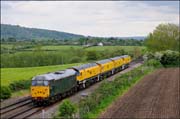 |
One of the few remaining class 31s to be active on the national network, 31452, took a new rail grinding set, numbers 79401 to 79404, to Okehampton on 5 May 2017. I wasn't able to get out for this but went for the return on Saturday 13 May when it ran as the 11.45 from Okehampton to Chaddesden Sidings, 4Z02.
My default location for a northbound afternoon shot on the Gloucester to Birmingham is Defford as it has a decent rural backdrop and if feeling lazy is very accessible. Although running as a class 4 the formation was limited to 45mph which meant that a number of loops were visited on the way north so it was just 2 minutes early
when it was heard coming over the River Avon at Eckington. The sun had disappeared in the few minutes since 66174 had gone south which was a pity but such a rare working was well worth recording, not just for the locomotive but also the consist which usually is seen only at night.
|
 |
One of the regular biennial rail events is due to take place at Long Marston during the week commencing 19 June 2016 and the first rail-borne exhibits arrived on Saturday 20 June 2016. This was a railvac hauled from Derby by 31452 and was about 10 minutes early arriving at Honeybourne in poor light on an afternoon that saw intermittent breaks at, unfortunately, the wrong time.
Running in front of 6Y31 was 1P51 from Great Malvern led by 43002 in a representation of its original colour scheme. I hadn't photographed this before so took a record shot although I do think that the admirable HSTs look best as designed; in a consistent overall livery.
|
 |
My primary target at Hatton on 11 February 2016 was 1Q04, a test train from Derby to Derby via Reading. I was expecting this to be led by Colas liveried 37421 which had been on the appropriate diagram earlier in the week but a couple of early messages
said the 31233 had replaced the 37. Anything is better than DRS 37s on these trains which have become a bit old hat but it was a surprise that a 31 had been turned out; I thought I had seen the last of these on such workings. The train reached Landor Street
some 40 minutes early and without knowing if the early running would continue I changed my plan to go to Bentley Heath as 1) I might not make in time and 2) if it did run early the sun would be too straight for a decent image. The road bridge at Hatton seemed
the best bet so that was the spot for me. 1Q04 turned up 12 minutes early with 97301 under power on the back of the formation completing the overall yellowness.
|
 |
A rare Saturday morning train to and from Long Marston ran on 28 March 2015 when DCR's 31190 took a single large box wagon from Washwood Heath to the site before picking up 86235 and 3 coaches which were scheduled to go to Leicester and East Leake respectively. I arrived
just after the inward working had reached the gate where it waited for a few minutes before being waved into the exchange sidings. It can be seen that the former No 1 road has been covered over with tarmac, presumably to make it easier and safer
for crews to carry out inspections of stock leaving the site. The Long Marston shunter removed the box wagon and 31190 was coupled onto the stock before the train, running as 6Z32, was moved onto the branch to Honeybourne at which point the wagon was propelled back so that 31190 and its train
could reverse a short way and recouple it to the consist.
|
 |
Given the unpleasant weather conditions on 28 March 2015 I originally had no intention of going anywhere for a second shot but then thought that a drive over
to Honeybourne would be worthwhile so as to take a wider view of the train with its interesting and unusual load. It wasn't long before 31190 poked its nose around the
bend in the background, stopped at the token cabin to replace the single line staff, and then ran forward into the branch road at Honeybourne station. As 6Z32 approached
the road bridge a clearish patch of sky came from nowhere and I was lucky enough to take this image in decent light witha nice dark sky before the sun was obscured again within a few seconds.
|
 |
There are quite frequent test trains along the North Cotswold Line and on Wednesday 30 April 2014 one ran from Derby to Kings Norton (later forming a separate train back to Derby) with 31233 leading a short formation
including a DBS. The weather at home was ideal with clear blue skies but as I drove to Evesham the warm sunshine triggered some heavy cumulus and cumulo-nimbus clouds. By the time I had arrived in Briar Close most of the sky was cloudy
although to the south some clear patches were forming. The train, 3Q13, had run early for most of its journey but was held close to right time mto allow a class 180 Adelante forming 1W21 from London Paddington to clear the single
line from Evesham West Junction to Norton Junction. Just as 31233 appeared in the distance the sun began to clear the cloud and by the time it was passing the signal box it was at about 95% strength. Good enough for me...
|
 |
Test trains powered by class 31 locomotives which run south along the Birmingham to Leamington Spa line are generally, in my experience, operated with the locomotive
propelling the coaches and DBS. I don't mind the occasional photograph of the formation this way round but would like to take one with the locomotive leading from time
to time. On Thursday 24 April 2014 a 3Z06 from Derby to Eastleigh ran which was reported as having 31285 leading so I made up my mind to go to Bentley Heath for a shot bearing
in mind that class 31s are slated for early withdrawal from this traffic. I've been writing that statement on and off for a couple of years now... Anyway, a booked stop at Small Heath South Junction
was missed out which meant that I wouldn't have made it to Dorridge in time so made a diversion to the nearest available location to my home and ending up at Hatton station roadbridge.
It wasn't long before the distinctive sound of a 31 was heard coming towards Hatton North Junction about 22 minutes early and just as the light began to improve from the very poor levels
that had ruled until that moment.
|
 |
The Ultrasonic Test Train started a week's tour on Monday 14 October 2013 by running from Derby to Alexandra Dock Junction via Long Marston. The locomotive was 31233 which led from Derby with DBS 9708 being on the other end of the formation ready for moves away from reversal points. Had the weather been decent I had
had several shots and a bit of chasing around in mind but with leaden skies and frequent heavy showers the order of the day I just went to an occupation crossing on the Long Marston branch for a record shot of this relatively unusual train on this line.
Running as 3Q22, the train left Derby around 50 minutes late but by avoiding the need to sit in various loops along the way was 5 minutes early when it passed me on one of the more overgrown parts of the track and going by an electricity supply pole gradually moving away from the vertical.
Because of the need to run, when recording, at no more than 30mph some lines are covered at night hence the array of spotlights on the front of 31233 used when video cameras are in use.
|
_LM_141013) |
After running to the end of the Long Marston branch on 14 October 2013 the crew of 3Q22 changed ends and headed back towards Honeybourne, Evesham and Worcester for another reversal before making their way to Alexandra Dock Junction. With DBS 9708 now leading the train ran cautiously over 3
occupation and foot crossings before 31233 was opened up to achieve line speed for the branch, 20mph. The better shots along here are for trains coming in this direction so maybe it would have been advantageous from a photographic point of view for 31233 to been leading for this leg but there haven't
been many DBS-led trains along here so I was happy enough, given the conditions, for things to have been the way they were.
|
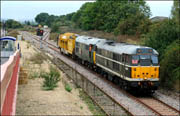 |
On Friday 13 September 2013 a light engine move was shown to run from Washwood Heath to Long Marston but this was cancelled before departure. It was replaced with a 6Z31 which was powered by DCR's 31190 + 31452 and turned out to be another Railvac move. I haven't seen much about 31452 recently
so thought that a picture would be in order. The shot at Honeybourne was the obvious one for me and I arrived just as RTT showed the train passing Evesham about 25 minutes early. It arrived within a few minutes and is here seen on the Long Marston branch having left the North Cotswold Line
at Honeybourne North Junction.
|
 |
My plan for the afternoon also included a trip to Hatton but as the road there took me past Long Marston I stopped off for another picture of 6Z31. I nearly missed it as I was chatting to a couple of friends picking sloes just down the road but just reached the bridge in time
for this view as the slightly mis-matched green pair arrived at the end of the branch from Honeybourne. The light was getting worse by the minute and some ominous looking clouds were building up in the Stratford direction. The train was due to continue to Eastleigh via Worcester,
Gloucester, Bristol and Salisbury although at this moment there was nothing visible in the yard as 6Z31 rolled into the exchange sidings. I didn't have time to hang around but understand that something else was picked up here and went off
with the Railvac also in the train's consist.
|
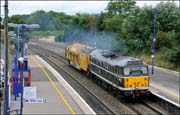 |
DCR is quite often contracted to run trains between Eastleigh, Westbury and the West Midlands for which green-liveried 31190 is generally used. On 13 August 2013 such a working took place when the locomotive was used to haul a Railvac from Westbury to Washwood Heath. The wondrous RealTime Trains proved its worth
yet again and showed that 6Z31 was in the Fenny Compton area not far off forty minutes early which meant that a quick trip to Hatton station was my best option to give a bit of background to a short formation. While waiting, a late running 4O09, the 10.18 Freightliner from Trafford Park to Southampton
ran through the station with 66565 + 66517 on the front. Not a shot that I would set out to take but as I was there... At this moment, 31190 was in Hatton Down Goods loop to allow a class 168 from Marylebone to overtake but was soon released and came through the platforms with a goodly amount of exhaust smoke and accompanying noise.
My interest in wagons is almost in negative territory but I did take another view of the Railvac as it went away in a cloud of smoke. I find it odd that the lamp posts on platforms 2 and 3 at Hatton are not vertical - I checked this image's "verticals" against other structures and the posts
are definitely leaning! I hate seeing photos taken on a slant, particularly when it so easy to correct, and always make an effort to ensure that mine are on the mark.
|
 |
Most of the locomotive-hauled test trains that visit Stratford-upon-Avon do so late in the evening meaning that some after dark photography can be practised. On Monday 29 July 2013
an unusual set of timings saw 3Q55, with DBS 9701 and 31285, arrive in daylight at 19.45 and indeed on a sunny evening. Here is the train arriving into platform 1 at the terminus
spot on time and just about managing to dodge most of the shadows. This view will soon be a thing of the past as planning notices have been issued giving notice that a new, additional, bridge
with lifts for disabled (and possibly lazy!) passengers is to be built roughly in the area of the two square gravel patches on the island platform.
|
 |
This test train, 3Q55, had originated from Derby and was headed for Didcot via Nuneaton, Coventry, Nuneaton, Washwood Heath, Stratford-upon-Avon, Leamington Spa, COD Kineton and Oxford. It left Stratford
right on time, 19.56, with quite a healthy noise from the elderly 31285 after a break to allow the driver to change ends. I am always happy to record another working with a class 31 in charge as they surely won't be doing this sort of work
for many more months. The light was lovely although the sun had just dropped enough for the shadow from the platform to encroach slightly on the train's wheels.
|
 |
A class 31 hauled test train ran north from Cornwall to Tyseley on Saturday 16 March 2013. The weather was horrible with heavy rain, low cloud and a cold wind but as class 31 locomotives are apparently soon to cease their work for Network Rail I tied
in a trip to a farm shop with a run to Hatton station to try for a photograph. The train, 3Q02, was running some ninety minutes earlier when it reached Leamington Spa but was held in the centre road for a short while to allow a CrossCountry Voyager to
pass by. I feel that station shots are sometimes better than open countryside in bad weather conditions as 1) a solid background looks better in misty conditions and 2) it is sometimes possible, as was the case today, to shelter under the footbridge!
Here then is 31233 leading its short train through the platforms while making a lot of noise on the 1/110 climb from Warwick. I saw 31233 at one of my favourite 1980s locations, Manchester Exchange on 27 February 1986
while in the company of 31289. I imagine that 31233 is probably just about the only thing in this old photograph still extant.
|
 |
I understand that Network Rail's association with class 31 haulage on their test trains is, in March 2013, about to finish so when I saw that 31465 was to visit Stratford-upon-Avon
during the night of 8 March I made up my mind to go for a shot. The train, running as 3Q01, the 22.27 from Tyseley to Derby via the West Midlands and Banbury, was due to arrive at the
terminus just after the 23.15 passenger train to Oxford had left so I arrived in plenty of time to set up my tripod and do a test exposure or two.
Night photography is so much simpler with good digital equipment than with film as it takes only a few seconds to ascertain the correct exposure rather than taking several with bracketed exposures
in the hope that one will be correct.
I heard 31465 approaching and saw that everything had worked out well with the DBS leading into platform 1 meaning that a shot of the 31 preparing for departure would be on the cards. The
crew soon had the locomotive's lights on and I was able to take four or five shots with slightly different exposures to hopefully ensure a decent result.
For anyone interested, the exposure on ISO 400 was 2.5 seconds at f13 with the colour temperature set to 3000K.
|
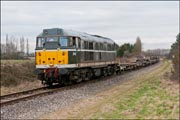 |
The third revenue earning train of the week used the Long Marston branch on Thursday 7 January 2013. DCR's 31190 in it's 1960's style green livery ran light diesel from Cardiff Riverside to collect a short set of flat wagons
which it was booked to take to Marcroft Engineering at Stoke-on-Trent. The inward movement, 0Z31, was about 20 minutes early arriving just after noon and I hoped that the loaded train, 6Z31, would get away early as the booked time
was 14.20; far longer than I wanted to hang about in the cold and rapidly deteriorating light. I drove around the corner from Long Marston and walked to one of the three foot crossings over the branch and had to wait only about
fifteen minutes before I heard the train rattling down the line to my position on a stile which gave just a little extra height. Because of the unprotected crossings, although virtually never used by walkers, the train had to slow
to a crawling place as it passed me. The early running, ninety-five minutes, didn't continue beyond Honeybourne where 6Z31 sat until its booked time before joining the North Cotswold Line to Evesham, Worcester and beyond. This was
not 31190's first visit to the line; here it is with a more colourful train at the "old" Honeybourne in November 2009.
|
 |
A train of stored coaching stock from Bletchley to Long Marston should have run on Thursday 13 December 2012 but problems were encountered when the locomotive, 31602, wouldn't start at Washwood Heath. In the event it ran later in the day but only as far as
Gloucester. Coincidentally, a train of three chemical tankers was booked to run from Gloucester to Long Marston on the same day but this was also cancelled. I was interested to learn therefore that both sets of stock were amalgamated on Friday 14th and that
the whole lot was booked to go to Long Marston around lunchtime. The weather had been dire with torrential rain but when I looked from my home towards the south-west at noon there was a small but definite improvement in the light. I went straight to Honeybourne station
and was pleasantly surprised to find that the sky was clearing and the sun was just about poking through the cloud. In fact, just before 6Z78 came into view at Honeybourne North Junction there was enough of a shadow to make me move down the ramp of the footbridge
because the shadow cast by the bridge was across the Long Marston branch. The train of DRS and Wrexham and Shropshire coaches tailed by the chemical tankers is here seen passing around the back of Honeybourne station's platforms as a class 180 Adelante heads off towards Evesham and Worcester.
|
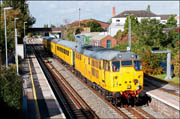 |
I believe that the Network Rail class 31s are shortly to lose their test train duties and be transferred to other work so when the opportunity for a shot of 31285 with the UTU on the North Cotswold Line presented itself on the morning on 17 October 2012 I thought that a trip to Evesham station
might be worthwhile. I took a bit of a gamble as I didn't know whether the locomotive or the DBS would be leading but hoped that the former would be the case as a lot of the up line through the platforms was shadowed thus not giving much of a chance of a going away shot, not that I like them anyway.
After a clear early part of the morning a lot of cloud began to build up during the drive from Stratford-upon-Avon and this added another unknown to the formula. Fortunately, the potential problems with the train's formation and the sun were resolved when 3Z13 from Tyseley to Bristol Kingsland Road via Worcester, Evesham, Oxford, Evesham,
Worcester and Bromsgrove came into view and ran into the station already showing some early signs of Autumnal colouration, especially in the shrub alongside the locomotive.
|
 |
A test train operated by DRS was buzzing around the South-East during the week commencing 1 October 2012 with locomotives 31106 and 37419 sandwiching three Network Rail coaches. I believe that class 31s will not be appearing on test trains for much longer so with the final run of the week being from Eastleigh to Derby
during the afternoon of 6 October I decided to go to Hatton North Junction if 1) the 31 was leading and 2) if there was a reasonable prospect of some decent light. Condition 1) was fulfilled and at around 4pm there was more sun than cloud in Stratford-upon-Avon so off I went in case there was some early running. In the event 1Q14 ran exactly
to time and arrived at 5pm in a patch of thick cloud in between quite long spells of beautiful evening sunshine.
|
 |
The Structure Gauging Train which had been working around the South-West and powered by 31105 was due to return to Derby RTC overnight on Friday 10 February 2012. The locomotive failed at Fenny Compton, just to the south of Leamington Spa, and on the following day 97304 was
sent light engine from Derby to rescue the train. I had assumed that 97304 would have been dropped onto the front of the failed class 31 but in the event it was clearly an easier move just to hook it up to the rear of the train and drive the whole lot from the dead 31105. By the
time 3Z15 had reached Hatton North Junction the light was rather low and the shadows rather longer than I should have wished so all in all not too successful an outing. In retrospect I would have better going a bit further south but when I left home I didn't know the timings
for the move so went to the closest location for me.
|
 |
One of the regular test trains from Derby to Eastleigh ran on 16 January 2012. On this occasion it ran as 3Z15, indicating that it was just a transit move and also as usual the locomotive, 31465, was marshalled on the back of the formation with
a DBSO providing the driver's accomodation. I wasn't going to wait at Hatton for this but it passed Tyseley some 35 earlier than scheduled so I thought that a short wait in the cold would be OK. Unfortunately, it was held to right time in Dorridge
up loop... The light was really past its best when the train appeared but as I was there I took a record shot.
|
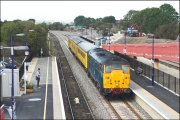 |
The first test train to run over the redoubled North Cotswold Line was scheduled for Monday 12 September 2011 and was booked for class 31 power along with a couple of coaches and a DBSO. It's seems quite often that the DBSO leads southbound trains of this sort from Derby but today rail blue 31106 was in charge and was on the front as 3Z13 headed from Worcester towards Oxford where it was to reverse, retrace its steps and then go south from Worcester yard to Bristol.
This suited me quite well as the light at Honeybourne, if the sun co-operated, would be in the perfect place. The train was reported some thirteen minutes late at Norton Junction but this tardiness increased to the point that it seemed possible that it had gone off-route at Norton and worked straight to Bristol. Just as I was giving up hope, the yellow front end of 31106 came into sight and ran slowly into
the new platform 2 where it was booked to stop for one minute. Unseen but not unheard was a down HST, 1W02, heading for Worcester which was right under my feet as I pressed the shutter. As can clearly be seen, the sun didn't make it to the station quite in time, being just visible in the background; but this bad fortune was soon to be reversed.
|
 |
The booked stop at Honeybourne of 31106 with 3Z13 to Bristol via Worcester, Oxford and Worcester took a bit longer than the one minute allowed in the schedule. The driver, after stretching his legs on the platform, returned to his locomotive and seemed to wait for the down HST to leave before
moving off towards Moreton-in-Marsh and Oxford. If this was deliberate then I am grateful; thank you, especially as the very strong winds had blown some clouds away in the last few moments! Some photographers would no doubt winge about a photograph like this because another train is in the shot but I really like the HST being there as it shows that the North Cotswold Line
is a revitalised route with the potential for improved time keeping and greater capacity. I think that this may be first locomotive-hauled train over the new up line, other than engineering trains which ran before the line was fully open, and it is certainly the first rail blue class 31
to have used the track. A lot of work in and around the station is still going on with the bulk of it concentrated on the new and very substantial footbridge, the source of quite a variety of new photographic opportunities.
|
 |
A Network Rail test train was scheduled to run from Bristol to Derby on Sunday 1 May 2011. Two class 31 locomotives, 31285 + 31465 were double-heading 3Z33 but problems with at least one of them caused the train to be held over at Banbury while things were sorted out. The original solution was to send a NR class 97 to top the train back to Derby on the following day
but in the event repairs were made which meant that the 31s didn't need any extra assistance. So, on the Monday morning, a new schedule was entered with the train booked to leave Banbury at 12.20 and run to Derby via Hatton and Birmingham. This time it ran to time and here seen making a quite leisurely climb of Hatton Bank with just 31285 providing the power
about 30 minutes before the light would have been in an ideal position. Still, the working was ususual enough for this not to matter too much...
|
 |
Test trains along the North Cotswold Line seem to be quite frequent at the moment and Wednesday 27 April 2011 saw an out and back run by 31602 with a track recording coach, generator vehicle and DBS. The train, running as 1Z13 from Derby to Bristol via Worcester and Oxford, had run south in the
late morning but the weather was quite dull so I decided to wait for the afternoon run back to Worcester in the hope that the sun would come out as had been forecast. The section of the line has recently seen the reinstatement of double track although as is clearly visible the new down side
has not yet been commissioned, 31602 leading its short train along what will become the up line when the work is complete.
|
 |
During my visits to Manchester Exchange and Victoria stations in 1985 and 1986 I was never fortunate enough to have access to a Freight Working Timetable. This meant that
I was rarely able to identify a working unless a local enthusiast was on hand to help out. I know that this train of loaded oil tanks pictured on 27 February 1986 probably came from the Stanlow refinery
but I have no idea of its destination. What I do know is that it was banked to the summit of Miles Platting bank because I heard the rumble of the class 37 together with the different sound of the 31s being
opened up a little while later. The leading locomotive is now in Network Rail yellow livery and here it is at Defford in January 2005 along with 31285
having been sent to rescue a failed NMT HST.
|
 |
Another test train ran from Derby RTC to Long Marston during the week commencing 24 October 2010, the return, 1Z15, being scheduled for Monday 1 November with a departure time of 13.44. Having seen the skies turn cloudy during the late morning I had just about decided not to bother
but when the sun started to break through at about 1.30pm I changed my mind and made for a bridge near the village of Aldington with, I thought, about 15 minutes to wait. Within about 90 seconds the yellow end of
31465 with its 3 vehicles in tow came into view and is here seen passing the distant signal and the treadle operating the barriers at Clayfield Lane crossing, some distance to the east. I was fortunate that the sun was just coming out of some thin cloud which gave an almost spotlight
appearance to the illumination. Much engineering work is ongoung around here in connection with the imminent redoubling of the line and several track workers are visible, returning to the small makeshift yard on the right of the track.
|
 |
A test train, 1Q11, was scheduled to run from Derby RTC to Long Marston on Monday 20 September 2010, with an arrival time of about 14.30. It left Derby about 200 minutes late, thus missing its path, and was given a new schedule timing it to pass Norton Junction, near Worcester just before 17.00. The chance of a late afternoon shot
gives a few different photographic opportunities on the Long Marston branch so I went across, more in hope than expectation that it would actually run. It didn't. The following morning saw me having a drive around Warwickshire and Gloucestershire in my Morris Minor so I took my camera and found myself at Long Marston at about 11.30,
a possible time for an arrival. There was no activity so I carried on with my toddle around the lanes, half of which were closed for resurfacing, before going home for lunch. A while later I had a text from a friend saying that 31285 had left Worcester Yard, where the train had spent the night, and was on the Cotswold Line so I
thought that I may as well have another try. Just as I arrived, the resident shunter was on its way along the exchange sidings and I could something rumbling along the branch and here is 31285 with one coach and a DBSO arriving 24 hours late in a lucky piece of cloud, the sun being almost exactly straight down the line when out. Note all the
lights and the camera mounted on the front.
|
 |
I hadn't previously seen a DBSO on the Long Marston although think that one may previously have visited on a day of dreadful weather so here is 9701 tailing 1Q11 and 31285 awaiting permission to enter the site. When the train had entered the exchange sidings,
the shunter pulled out of the headshunt and was attached to the DBSO before the crews, just about visible, went off towards the control tower. The scene on the previous day was quite similar when a Virgin liveried
class 86 was being moved after an open day on Sunday.
|
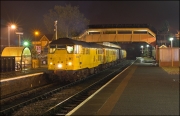 |
A rare nocturnal locomotive-hauled move to Stratford-upon-Avon ocurred on Tuesday 28 October 2008. The Structure Gauging Train, running as 1Q06, the 17.59 Derby RTC to Derby RTC via Stratford left Derby about 30 minutes late, but with a similar layover scheduled at Snall Heath I didn't expect much delay
by the time it reached my home town. I had a call from a signaller friend when 1Q06 was at Shirley on the North Warwickshire Line and this was my cue to make the short journey from home to the station. It was a very cold evening following some heavy snow during the late afternoon and platform 2 at Stratford
was not the cosiest place to be at 20.35! The final train of the day to Birmingham and Stourbridge Junction hadn't been gone many minutes when 31233 heading the SGT with 31105 on the back rumbled around the curve and into the platform.
|
_SonA_281008.jpg) |
The Structure Gauging Train was booked to stand at Stratford-upon-Avon for about 10 minutes so I waited for the driver to switch on the lights on the front of 31105 before taking my photographs. It is many years since last I did any night shooting
but I did remember that an exposure of 15 second at f5.6 using 100ASA film used to give a good result here, so that was my starting point on 28 October 2008. I like the effect of the differing colour temperatures of the street lighting in the background
and the starburst caused by the long exposure. The road was already set and the platform-end signal showing a green aspect and it wasn't long before the driver blew his horn to mark the end of photography for the evening and went off with a wave into the dark. The laser
gauging beam was switched back on as the train moved off, giving quite a show on the curve out of the station. I should have taken my video camera too...
|
 |
Two trains with "Z" headcodes were booked to pass Hatton in the late morning on 3 November 2008. The first was 1Z12 from Derby RTC to Lovers Walk (Brighton) and comprised of a Network DBSO and coach propelled by green liveried 31190. Presumably because the locomotive was on the back of the train, it elicited very
little enthusiast interest and just one posting on an email group appeared on my BlackBerry. Here is 1Z12 about to pass Hatton station in very poor light a few minutes early with 31190 producing a fair amount of noise and exhaust smoke.
|
 |
A rake of Mk2 coaching stock has been trying to escape from Long Marston for a couple of weeks but for various reasons apparently revolving around school holidays and
unavailable locomotives, it didn't happen until 9 November 2009. The motive power on the day changed from 47812 to 31190, the green liveried locomotive running light diesel
from Washwood Heath to collect the coaches. An early departure from Long Marston took place but the train, 5Z47 to Barrow Hill, had to stand time on the former East Loop
at Honeybourne until both an up and a down train had passed and cleared the single line between Moreton in Marsh and Evesham.
Here, 31190 and the six coaches stand on the loop from Long Marston in quite dark and misty conditions, the Cotswold Hills being virtually obscured by the murk.
|
 |
As soon as the HST shown in the linked picture above had reached Evesham it was possible for a cew member from 31190 to insert the key in the ground frame at Honeybourne swith the points and call
5Z47 to come over the spur and onto the Cotswold Line spot on time at 13.25. The train was then to run via Evesham, Worcester, Droitwich Spa and the Lickey Incline to Birmingham and on to its
destination at Barrow Hill. This shot will not be possible by this time next year when the Cotswold Line receives double track as trains from Long Marston will run on the tracks on the extreme
left of this picture past the platforms at Honeybourne station and join the main line just south of the platforms.
|
 |
A test train, the first to run over the line since a major possession during the summer, went up and down the North Cotswold Line on 23 September 2009. I wasn't able to photograph the morning run in the up direction but did go over to Evesham
for the return from Oxford. The train, 4Z10 from Derby, was powered by 31106 which has recently been repainted in the rail blue that it carried in earlier times. I don't, these days, chase around as soon as a new paint job appears but prefer
to wait until the locomotive comes within easy reach before getting a picture. If that happens to be a nice sunny shot then that's great, but on this occasion the sun was firmly covered as the train approached Evesham station so I took the opportunity
to take the photograph from the north side of the line, meanwhile hoping that an opportunity for a sunny shot will come along soon. The locomotive was very clean and reflections from the vegetation in the cutting are clearly visible. Note also the lower quadrant
signal in the background; it looks very much as if the signal wire tensioner needs a turn or two as the angle of the arm seems a little awry.
|
 |
Now and again, late running of a train is an advantage to the photographer. This was case on 5 February 2009 when 4Q08, the Laira to Derby test train ran some 270 minutes behind schedule. I wasn't
expecting to see this but the late running gave the opportunity for a shot, despite the uncomfortable coldness getting through my walking boots and into my toes after a couple of hours at Hatton North Junction.
The train could be heard for ages on the climb of Hatton Bank, the relatively light traffic on the adjacent M40 for once not masking the sound. 31190 propelling DBO 9703 and 2 coaches was going at quite a speed
when it came around the bend from Hatton station, the crew no doubt keen to make up some time and get home.
|
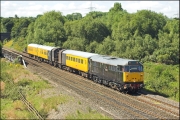 |
A small bonus during the morning of 8 August 2007 was the appearance of 31459 with a trial run of the Structure Gauging Train. This was running as 1Q06 from Derby to Derby via Birmmingham New Street and due to what appeared to be some dodgy regulation was allowed out of Derby in front of
a Virgin Voyager. This resulted in it being routed via the slow lines at Kingsbury Junction rather than Lea Marston. This didn't bother me too much as the southbound shot here isn't that brilliant, especially for a very short train. Here is the return working pictured at 11.35 with 31459
pulling away from a signal check. It looks as if the train has recently been freshly painted and it gave a chance to have a closer look at the stock - I don't recall having seen it in daylight before; it appears to be a mostly nocturnal set.
|
 |
The test trains operated by Network Rail are undergoing significant changes to their motive power and mode of operation. In connection with this a DBSO formerly used by Anglia Railways has recently been on trial. This will eliminate the expensive use of topped-and tailed locomotives and will, no doubt, be a source of irritation to photographers who are obsessed
with the traction source. Personally, I find these vehicles to be of arguably more interest than a 40 year old class 31, of which everyone has had plenty of opportunities to obtain photographs.
This train, 5Z47 from Foxhall Junction, Didcot to Derby is seen about to pass under the footbridge at Hatton North Junction with 31105 propelling DBSO 9714. Use the hyperlink for a closer look at the
DBSO on its run south to Didcot earlier in the day. The use of Foxhall Junction as the destination of the southbound run was to allow the formation to reverse on the triangle at Didcot to allow the DBSO to be tested.
|
 |
The date of this photograph is 2 May 1984 and it shows 31126 propelling its train of ballast wagons into the CCE sidings at Guide Bridge. There were many such
workings in this area at the time and I saw representatives of class 25, 31, 37, 40, 45 and 47 doing the honours on just a couple of visits. This really was a
busy location and the atmosphere of the vintage railway here was tremendous, not least because of the 1500 volt DC electrification and the regular passage of class 506
units. How I wish I'd been here earlier when the DC locomotives of class 76 and 77 were in use. It was not only the railway that was vintage in retrospect - just look at the cars in the adjacent parking lot!
|
 |
The regular cement trains from Earles Sidings to Greaves sidings, near Harbury were, by 1985, generally in the hands of class 47 locomotives. However, on 3 August 1985 a pair of 31s
were diagrammed for the duty as shown here as the train, headed by 31280 + 31188 awaits a path south of Leamington Spa. Quite a gap in traffic would be needed as the sidings were on
the down side. This train would have had to be propelled from the up track and across across the down to access the sidings. The heavy train would have made the locomotives
work hard on the stiff climb past Whitnash and onwards to Harbury tunnel. One of the ubiquitous class 116 DMUs is sitting in the down platform with
a train bound for Birmingham Moor Street.
|
 |
Here is an earlier shot of 31280 passing Leamington Spa taken on 26 May 1984, but this time on a much more unusual duty. 56099 had failed with its train of car-carrying vehicles and the 31 must have been summoned to rescue it. I
don't know the working involved but imagine that the destination was either Dorridge sidings or Small Heath in Birmingham. The time was 07.00 and I was on my way to London to sit an examination, but luckily remembered
to pack my camera just in case. Note the array of class 116 DMUs in the platforms; the one in which I had arrived from Stratford in visible to the left, in platform 3.
|
 |
Worcester still had a dedicated parcels service in December 1984, which the local catalogue used extensively to despatch its goods. Here is 31289 with the 3V16 Birmingham Curzon Street to Worcester van
on the 15 December passing the station prior to shunting the van into position for loading. The ballast hoppers in the background are also worth a glance; there are not many of those around in 2006.
|
 |
Just about everything in this photograph has gone. 31286 was standing on the down goods loop outside Stratford-upon-Avon station with the Chipmans weedkilling train on 16 June 1987. The signal box, signals and gas holders have long since disappeared,
the loop itself has been lifted and the locomotive and stock have been scrapped.
|
 |
Earlier on the same day as the picture shown further up the page, and in the only bit of sun I saw all day, 31142 took a few containers to Dudley freightliner terminal. This shot was taken from the canal towpath at Dudley Port which meant that the only available shot was one of the loco going away. It was fortuitous
that there was an empty flat behind the locomotive.
|
 |
Not far from the above picture as the crow flies, but a long way in terms of an operating railway is this shot of 31456+31441 on the Manchester to Paignton Pullman train on Saturday
19 June 1986. 31s were the booked motive power for this train which gave an extra touch of variety to the line out of Birmingham Street. The photograph was taken at Longbridge station in the days
before Cross-City electrification was even a spark of an idea. The following Saturday saw a class 58 on this train - click on the hyperlink to see 58025 doing the business.
|
 |
31414 was selected to receive a bizarre colour scheme of two shades of blue, full yellow cabs and red buffer beams with the colour extended underneath the cabs. I was keen to get a record of the locomotive, but in the days before mobile communication became portable it was not easy to find out what
any particular engine was doing on any particular day. This was one of the reasons for a visit to the first SVR diesel gala on 7 May 1988 as it was hired in to attract the punters. The train is seen here approaching Bewdley Tunnel with one of the morning workings from Bridgnorth. 645
|
 |
An ECS move from Carnforth to Didcot was run on Friday 22 April 2005 to provide stock for a private steam charter the following day. FragonsetFwhitacre's 31454, in Intercity livery complete with the Swallow motif
was provided to power the stock which is seen here passing Hatton Station Junction at 17.33, some 30 minutes later than the booked time and in predictably awful light.
|
 |
Steam enthusiasts were in kettle heaven on 26 October 1986 when both Mallard and Sir Nigel Gresley were booked to run from London to Stratford-upon-Avon only 1 hour apart. As was usual at the time,
diesel locos were used to bring the train from Banbury to Stratford. Instead of the 45,47 or 50, on this day the trains arrived behind 31s. Had I know this in advance I would have chosen a better location but
here is a view of an ex-works 31407 passing Wilmcote showing my attempt to incorporate some autumnal colours into the scene.
|
 |
A pair of 31s is seen here leaving Stratford-upon-Avon with another Sunday morning engineering train. It is using the very rarely-used crossover from the down to the up line and I do remember that the signalman was not at all happy about this move, fearing that
the train would end up "in the dirt". The unusual viewpoint was chosen to best capture this movement and to be out of the way if the worst happened! The recently severed connection to the former down goods loop can be seen on the left of the train.
|




_10020.jpg)

_1Q16_SonA_070608.jpg)



























_4z08_evesham_0306.jpg)


_eagle_xing_16687.jpg)













_SonA_281008.jpg)

















